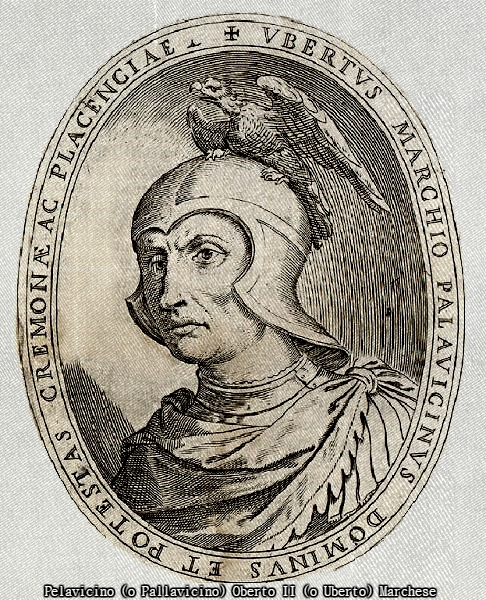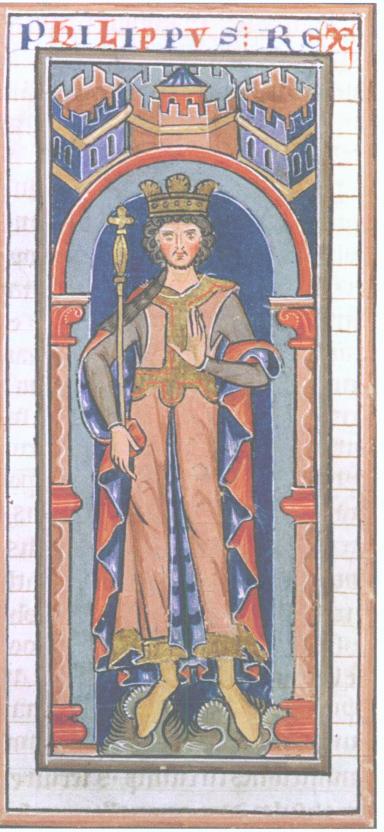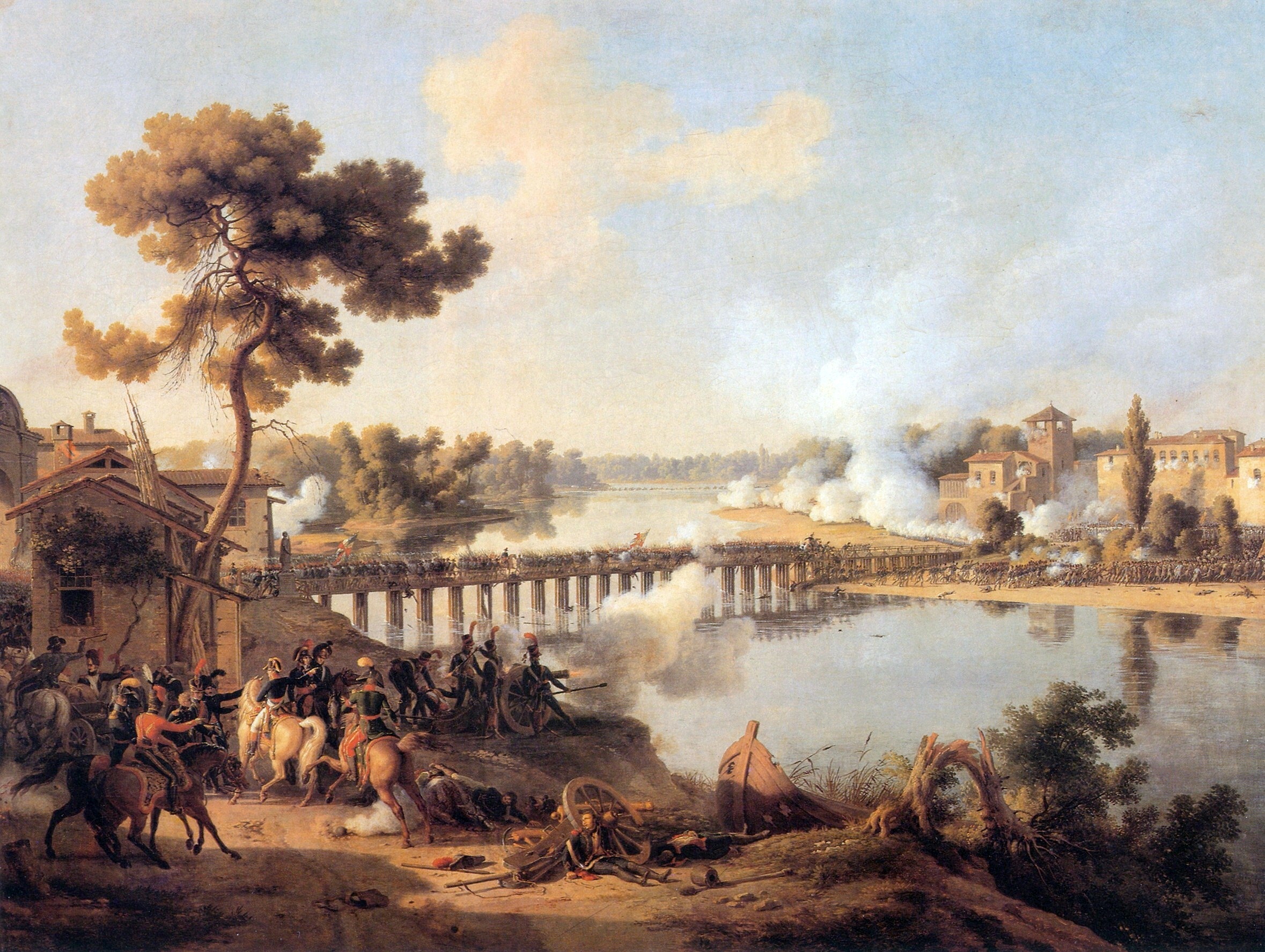|
Uberto Pallavicini
Oberto (or Uberto) Pallavicino (1197–1269) was an Italian military commander who served under Frederick II, Holy Roman Emperor. He was a member of the lombard branch of the Pallavicini family. Pallavicino supported Frederick II against Pope Gregory IX as early as 1234. Beginning in 1250, he successfully brought several key Lombard cities: Parma, Cremona, Piacenza, Pavia, and Brescia under imperial control. A significant primary source documenting this phase of his career is an imperial charter issued by Frederick II in November 1250, in which the emperor grants Pallavicino the authority to offer imperial clemency and legal immunity to subjects from Piacenza and surrounding territories. The document also confirms that any promises or agreements made by Pallavicino on behalf of the emperor would be ratified by the imperial court. This charter was rediscovered in 2011 in a box of manuscript fragments at the Schottenstift Archive in Vienna. Due to growing rivalry with Ezzelino ... [...More Info...] [...Related Items...] OR: [Wikipedia] [Google] [Baidu] |
Uberto II Pallavicino
Uberto is an Italian first name, the equivalent of Hubert; variations include Oberto, Ubertino and female forms are Uberta, Oberta, Ubertina. Notable people with this name include: * Uberto Allucingoli, Italian cardinal * Sante Uberto Barbieri, bishop of the Methodist Church * Ubertino I da Carrara, (died 1345), Lord of Padua * Ubertino of Casale (1259–1329), Italian Fransciscan * Pope Urban III, born Uberto Crivelli * Uberto Lanfranchi (died 1137), Archbishop of Pisa * Uberto De Morpurgo (1896–1961), Austrian-born Italian tennis player * Ubertino Pallavicini (died 1278), Margrave of Bodonitsa * Uberto Pasolini (born 1957), Italian film producer and director * Uberto Zanolli Uberto Zanolli (1917–1994), the son of Amelia Pìa Balugani Vecchi and Luigi Zanolli Marcolini, was an Italo-Mexican composer, conductor and writer. An engineer official for the Italian army during World War II, he was a prisoner in Nazi con ..., Italo-Mexican composer Italian masculine given nam ... [...More Info...] [...Related Items...] OR: [Wikipedia] [Google] [Baidu] |
Ezzelino III Da Romano
Ezzelino III da Romano (25 April 1194, Tombolo, Veneto, Tombolo7 October 1259) was an Italian feudal lord, a member of the Ezzelini family, in the March of Treviso (in modern Veneto). He was a close ally of the emperor Frederick II, Holy Roman Emperor, Frederick II (Reign, r. 1220–1250), and ruled Verona, Vicenza and Padua for almost two decades. He became infamous as a cruel tyrant, and was, in fact, the most "notorious" of the "early tyrants". Biography Early life Ezzelino was a son of Ezzelino II da Romano, ruler of Bassano del Grappa and other fiefs in the Veneto, and Adelaide D'egli Alberti di Mangona, who came from a family of counts in Tuscany. At the age of four years, he was sent as a hostage to Verona, but nothing else is known about his childhood or education. In 1213, he took part in the siege of the castle of Este, Italy, Este, which belonged to his father's archenemy, marquess Azzo VI of Este, who died in 1212 and later to his son Aldobrandino. According to th ... [...More Info...] [...Related Items...] OR: [Wikipedia] [Google] [Baidu] |
1269 Deaths
1 (one, unit, unity) is a number, numeral, and glyph. It is the first and smallest positive integer of the infinite sequence of natural numbers. This fundamental property has led to its unique uses in other fields, ranging from science to sports, where it commonly denotes the first, leading, or top thing in a group. 1 is the unit of counting or measurement, a determiner for singular nouns, and a gender-neutral pronoun. Historically, the representation of 1 evolved from ancient Sumerian and Babylonian symbols to the modern Arabic numeral. In mathematics, 1 is the multiplicative identity, meaning that any number multiplied by 1 equals the same number. 1 is by convention not considered a prime number. In digital technology, 1 represents the "on" state in binary code, the foundation of computing. Philosophically, 1 symbolizes the ultimate reality or source of existence in various traditions. In mathematics The number 1 is the first natural number after 0. Each natural nu ... [...More Info...] [...Related Items...] OR: [Wikipedia] [Google] [Baidu] |
1197 Births
Year 1197 ( MCXCVII) was a common year starting on Wednesday of the Julian calendar. Events By place Europe * Spring – Emperor Henry VI travels to Italy to persuade Pope Celestine III to crown his infant son Frederick II, who has been elected "King of the Romans" at Frankfurt. * King Richard I (the Lionheart) has Château Gaillard (Normandy) built on the Seine River as he fights to restore Angevin power in northern France (approximate date). * Summer – Henry VI takes cruel measures to put down Jordan Lupin's insurrection in Sicily and southern Italy, which has been provoked by the oppression of his German officials. * June/July – German crusaders launch an attack on Silves. * September 28 – Henry VI dies of malaria at Messina (also possibly poisoned), while preparing an expedition against the Byzantine usurper Alexios III (Angelos). * Autumn – A German civil war begins upon the sudden death of Henry VI. Henry's brother, Philip of ... [...More Info...] [...Related Items...] OR: [Wikipedia] [Google] [Baidu] |
Ghibellines
The Guelphs and Ghibellines ( , ; ) were factions supporting the Pope (Guelphs) and the Holy Roman Emperor (Ghibellines) in the Italian city-states of Central Italy and Northern Italy during the Middle Ages. During the 12th and 13th centuries, rivalry between these two parties dominated political life across medieval Italy. The struggle for power between the Papacy and the Holy Roman Empire arose with the Investiture Controversy, which began in 1075 and ended with the Concordat of Worms in 1122. History Origins The conflict between Guelphs and Ghibellines arose from the political divisions caused by the Investiture Controversy, about whether secular rulers or the pope had the authority to appoint bishops and abbots. Upon the death of Emperor Henry V, of the Salian dynasty, the dukes elected an opponent of his dynasty, Lothair III, as the new emperor. This displeased the house of Hohenstaufen, who were allied with and related to the old dynasty. Out of fear of the Hohen ... [...More Info...] [...Related Items...] OR: [Wikipedia] [Google] [Baidu] |
Charles I Of Anjou
Charles I (early 1226/12277 January 1285), commonly called Charles of Anjou or Charles d'Anjou, was King of Sicily from 1266 to 1285. He was a member of the royal Capetian dynasty and the founder of the House of Anjou-Sicily. Between 1246 and 1285, he was Count of Provence and Forcalquier in the Holy Roman Empire and Count of Anjou and Maine in France. In 1272 he was proclaimed King of Albania, in 1277 he purchased a claim to the Kingdom of Jerusalem, and in 1278 he became Prince of Achaea after the previous ruler, William of Villehardouin, died without heirs. The youngest son of Louis VIII of France and Blanche of Castile, Charles was destined for a Church career until the early 1240s. He acquired Provence and Forcalquier through his marriage to their heiress, Beatrice. His attempts to restore central authority brought him into conflict with his mother-in-law, Beatrice of Savoy, and the nobility. He relinquished control of Forcalquier to his mother-in-law in 1248, a ... [...More Info...] [...Related Items...] OR: [Wikipedia] [Google] [Baidu] |
Alessandria
Alessandria (; ) is a city and commune in Piedmont, Italy, and the capital of the Province of Alessandria. It is also the largest municipality of the region. The city is sited on the alluvial plain between the Tanaro and the Bormida rivers, about east of Turin. Alessandria is also a major railway hub. History Alessandria was founded in 1168 with a charter as a free comune; it was sited upon a preexisting urban nucleus, to serve as a stronghold for the Lombard League, defending the traditional liberties of the communes of northern Italy against the Imperial forces of Frederick Barbarossa. Alessandria stood in the territories of the marchese of Montferrat, a staunch ally of the Emperor, with a name assumed in 1168 to honour the Emperor's opponent, Pope Alexander III. In 1174–1175 the fortress was sorely tested by the Imperial siege and stood fast. A legend (related in Umberto Eco's novel ''Baudolino'', and which recalls one concerning Bishop Herculanus’ successful d ... [...More Info...] [...Related Items...] OR: [Wikipedia] [Google] [Baidu] |
Tortona
Tortona (; , ; ) is a ''comune'' of Piemonte, in the Province of Alessandria, Italy. Tortona is sited on the right bank of the Scrivia between the plain of Spinetta Marengo, Marengo and the foothills of the Ligurian Apennines. Its ''frazione'' of Vho is one of I Borghi più belli d'Italia ("The most beautiful villages of Italy"). History Known in ancient times as Dertona, the city was probably the oldest colony under Roman rule in the westernmost section of the Valley of the Po River, Po, on the road leading from Genoa, Genua (Genoa) to Placentia, Italy, Placentia (Piacenza). The city was founded c. 123–118 BC at the junction of the great roads; the Via Postumia and the Via Aemilia Scauri which merged to become the Via Julia Augusta. The site made Dertona an important military station under the Romans. Strabo speaks of it as one of the most considerable towns in this part of Italy, and from Pliny the Elder, Pliny wrote that it was a Roman colony. Velleius mentions it ... [...More Info...] [...Related Items...] OR: [Wikipedia] [Google] [Baidu] |
Novara
Novara (; Novarese Lombard, Novarese: ) is the capital city of the province of Novara in the Piedmont (Italy), Piedmont region in northwest Italy, to the west of Milan. With 101,916 inhabitants (on 1 January 2021), it is the second most populous city in Piedmont after Turin. It is an important crossroads for commercial traffic along the routes from Milan to Turin and from Genoa to Switzerland. Novara lies between the streams Agogna and Terdoppio in northeastern Piedmont, from Milan and from Turin. It is only distant from the river Ticino, which marks the border with Lombardy region. History Novara was founded around 89 BC by the Ancient Rome, Romans, when the local Gauls obtained Roman citizenship. Its name is formed from ''Nov'', meaning "new", and ''Aria'', the name the Cisalpine Gauls used for the surrounding region. Ancient ''Novaria'', which dates to the time of the Ligures and the Celts, was a municipium and was situated on the road from Vercellae (Vercelli) to (Mediol ... [...More Info...] [...Related Items...] OR: [Wikipedia] [Google] [Baidu] |
Lodi, Lombardy
Lodi ( , ; Western Lombard, Ludesan: ) is a city and ''comune'' (municipality) in Lombardy, northern Italy, primarily on the western bank of the Adda River, Italy, River Adda. It is the capital of the province of Lodi. History Antiquity Lodi was a Celts, Celtic village; in ancient Rome, Roman times it was called, in Latin, Laus Pompeia (probably in honour of the consul Gnaeus Pompeius Strabo) and was known also because its position allowed many Gauls of ''Gallia Cisalpina'' to obtain Roman citizenship. It was in an important position where a vital Roman road crossed the Adda (river), River Adda. Lodi became the Holy See, see of a Roman Catholic Diocese of Lodi, diocese in the 3rd century. Saint Bassianus (San Bassiano) is the patron saint of the town. Middle Ages A Medieval commune, free commune around 1000, it fiercely resisted the history of Milan, Milanese, who destroyed it in 1111. The old town corresponds to the modern Lodi Vecchio. Frederick Barbarossa rebuilt it on it ... [...More Info...] [...Related Items...] OR: [Wikipedia] [Google] [Baidu] |
Como
Como (, ; , or ; ) is a city and (municipality) in Lombardy, Italy. It is the administrative capital of the Province of Como. Nestled at the southwestern branch of the picturesque Lake Como, the city is a renowned tourist destination, celebrated for its stunning landscapes, artistic heritage, and cultural significance. Its prime location on the shores of Lake Como and its proximity to the majestic Alps has made Como a popular destination for tourists. The city boasts a rich collection of art, religious sites, verdant gardens, museums, theatres, public parks, and opulent palaces, including the iconic ''Duomo'', seat of the Diocese of Como; the Basilica of Sant'Abbondio; Villa Olmo; the public gardens with the Tempio Voltiano; the Teatro Sociale; the ''Broletto'', the city's medieval town hall; and the 20th-century Casa del Fascio, a landmark of modernist architecture. Como has been the birthplace of numerous notable historical figures, including the Roman poet Caecili ... [...More Info...] [...Related Items...] OR: [Wikipedia] [Google] [Baidu] |
Milan
Milan ( , , ; ) is a city in northern Italy, regional capital of Lombardy, the largest city in Italy by urban area and the List of cities in Italy, second-most-populous city proper in Italy after Rome. The city proper has a population of nearly 1.4 million, while its Metropolitan City of Milan, metropolitan city has 3.2 million residents. Within Europe, Milan is the fourth-most-populous List of urban areas in the European Union, urban area of the EU with 6.17 million inhabitants. According to national sources, the population within the wider Milan metropolitan area (also known as Greater Milan) is estimated between 7.5 million and 8.2 million, making it by far the List of metropolitan areas of Italy, largest metropolitan area in Italy and List of metropolitan areas in Europe, one of the largest in the EU.* * * * Milan is the economic capital of Italy, one of the economic capitals of Europe and a global centre for business, fashion and finance. Milan is reco ... [...More Info...] [...Related Items...] OR: [Wikipedia] [Google] [Baidu] |








